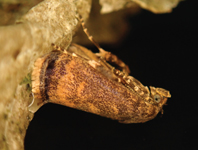Abstract
The Flora and Fauna Protection Area (Área de Protección de Flora y Fauna—ÁPFF) Cerro del Mohinora, is the highest mountain in northern Mexico, reaching an elevation of 3,300 meters. It constitutes one of the last high-elevation islands of alpine and subalpine vegetation known in the Sierra Madre Occidental, in the extreme southwestern part of Chihuahua. The ÁPFF Cerro del Mohinora is located near the state border and limits with Durango and Sinaloa. This type of ecosystem located at high altitudes is in danger of disappearing since only 1% or less of its original extension remains; it is considered a refuge for species with boreal affinities (McDonald et al. 2011).
References
Acosta, R., Fernández, J.A., Llorente, B.J. & Jiménez, M.C. (2008) Catálogo de Pulgas (Insecta: Siphonaptera). Serie de Catálogos del Museo de Zoología “Alfonso L. Herrera UNAM. Las Prensas de Ciencias, UNAM, México, D.F., 111 pp.
Aguilar-Montiel, F., Estrada-Torres, A., Acosta, R., Rubio-Godoy, M. & Vázquez, J. (2018) Host species influence on flea (Siphonaptera) infection parameters of terrestrial micromammals in a temperate forest of Mexico. Parasitology, 146, 670–677.
https://doi.org/10.1017/S0031182018001981
Bitam, I., Dittmar, K., Parola, P., Whiting, M.F. & Raoult, D. (2010) Fleas and flea-borne diseases. International Journal of Infectious Diseases, 14, e667–e676.
https://doi.org/10.1016/j.ijid.2009.11.011
Churchfield, S. (1990) The natural history of shrews. Comstock Publishing Associates, Ithaca, New York, 178 pp.
Durden, L.A. & Keirans, J.E. (1996) Nymphs of the genus Ixodes (Acari: Ixodidae) of the United States: taxonomy, identification key, distribution, hosts, and medical/veterinary importance. Entomological Society of America, Annapolis, Maryland, 95 pp.
Gregson, J.D. (1942) A new species of tick found on shrews. Canadian Entomologist, 74, 137–139.
https://doi.org/10.4039/Ent74137-8
Guzmán-Cornejo, C. & Robbins, R.G. (2010) The genus Ixodes (Acari: Ixodidae) in Mexico: adult identification keys, diagnoses, hosts, and distribution. Revista Mexicana de Biodiversidad, 81, 289–298.
https://doi.org/10.22201/ib.20078706e.2010.002.254
Hall, E.R. (1981) The mammals of North America. John Wiley & Sons, New York, 690 pp.
Hopkins, G.H.E. & Rothschild, M. (1966) An illustrated catalogue of the Rothschild Collection of fleas (Siphonaptera) in the British Museum (Natural History). Vol. IV. Hystrichopsyllidae. British Museum of Natural History, London, 549 pp.
Jameson, E.W. (1946) The geographic range of Ixodes soricis Gregson. Canadian Entomologist, 78, 200.
https://doi.org/10.4039/Ent78200-11
Keirans, J.E. & Clifford, C.M. (1978) The genus Ixodes in the United States: a scanning electron microscope study and key to the adults. Journal of Medical Entomology, 15 (Supplement 2), 1–38.
https://doi.org/10.1093/jmedent/15.suppl2.1
Lindquist, E.E., Galloway, T.D., Artsob, H., Lindsay, L.R., Drebot, M., Wood, H. & Robbins, R.G. (2016) A handbook to the ticks of Canada (Ixodida: Ixodidae, Argasidae). Biological Survey of Canada Monograph Series, No. 7, 11–317.
https://doi.org/10.3752/9780968932186
Martínez, M.J. (1991) Flora y fitogeografía de la vegetación alpina y subalpina del Cerro Mohinora, Sierra Madre Occidental, Chihuahua, México. Investigación y Ciencia, 3, 26–28.
McDonald, J.A., Martínez, J. & Nesom, G.L. (2011) Alpine flora of Cerro Mohinora, Chihuahua, Mexico. Journal of the Botanical Research Institute of Texas, 5, 701–705.
Montiel-Parra, G., Carlos-Delgado, A.L., Paredes-León, R. & Pérez, T.M. (2019) Epizoic arthropods of the Mexican Shrew, Sorex oreopolus (Mammalia: Soricidae). Therya, 10, 33–37.
https://doi.org/10.12933/therya-19-715
Morrone, J.J. & Acosta, R. (2006) A synopsis of the fleas (Insecta: Siphonaptera) parasitizing New World species of the Soricidae (Mammalia: Insectivora). Zootaxa, 1354, 1–30.
Robbins, R.G. & Keirans, J.E. (1992) Systematics and ecology of the subgenus Ixodiopsis (Acari: Ixodidae: Ixodes). Thomas Say Foundation Monographs. Vol. XIV. Entomological Society of America, Lanham, Maryland, 159 pp.
Sikes, R.S., Gannon, W.L. & The Animal Care and Use Committee of the American Society of Mammalogists (2011) Guidelines of the American Society of Mammalogists for the use of wild mammals in research. Journal of Mammalogy, 92, 235–253.
https://doi.org/10.1644/10-MAMM-F-355.1
Smith, M.E. & Belk, M.C. (1996) Sorex monticolus. Mammalian Species, 528, 1–5.
https://doi.org/10.2307/3504177
Spencer, G.J. (1963) Attacks on humans by Ixodes angustus Neumann, the coast squirrel tick, and I. soricis Gregson, the shrew tick. Proceedings of the Entomological Society of British Columbia, 60, 40.


